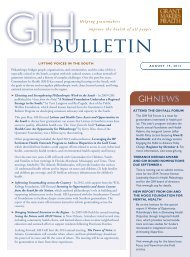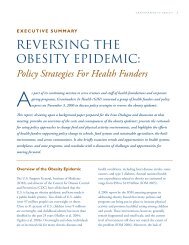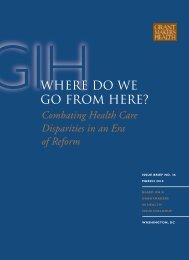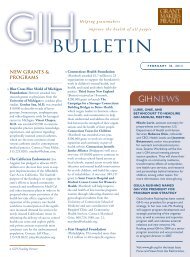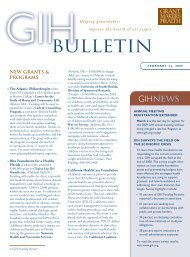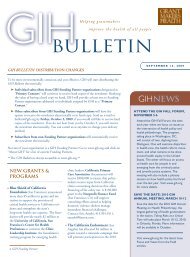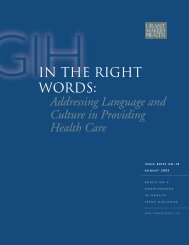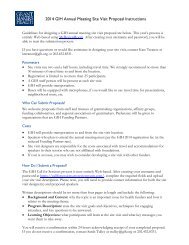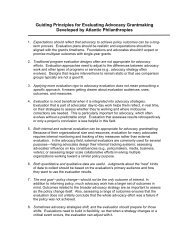Philanthropy and Nursing - GIH - Grantmakers In Health
Philanthropy and Nursing - GIH - Grantmakers In Health
Philanthropy and Nursing - GIH - Grantmakers In Health
You also want an ePaper? Increase the reach of your titles
YUMPU automatically turns print PDFs into web optimized ePapers that Google loves.
<strong>Philanthropy</strong> <strong>and</strong> <strong>Nursing</strong><br />
<strong>Grantmakers</strong> <strong>In</strong> <strong>Health</strong> – March 19, 2009<br />
Gordon <strong>and</strong> Betty Moore Foundation,<br />
Northwest <strong>Health</strong> Foundation,<br />
Robert Wood Johnson Foundation <strong>and</strong><br />
The Dorothy Rider Pool <strong>Health</strong> Care Trust
Panelists / Presenters<br />
• Susan Hassmiller, PhD, RN, FAAN<br />
Senior Advisor for <strong>Nursing</strong>,<br />
Robert Wood Johnson Foundation<br />
• Marybeth Sharpe, PhD<br />
<strong>In</strong>itiative Lead, Betty Irene Moore <strong>Nursing</strong> <strong>In</strong>itiative<br />
Gordon <strong>and</strong> Betty Moore Foundation<br />
• Judith L. Woodruff, JD<br />
Program Director, Partners <strong>In</strong>vesting in <strong>Nursing</strong>'s Future<br />
Program Director, <strong>Nursing</strong><br />
Northwest <strong>Health</strong> Foundation<br />
• Joseph Napolitano, PhD, MPH, CRNP<br />
Program Officer<br />
The Dorothy Rider Pool <strong>Health</strong> Care Trust
Goals of Presentation<br />
• To increase awareness of the scope, magnitude<br />
<strong>and</strong> challenges of the nursing profession<br />
• To exp<strong>and</strong> underst<strong>and</strong>ing as to how professional<br />
nurses play a key role in their respective<br />
organizational missions <strong>and</strong> program areas<br />
• To encourage interest in supporting nursing<br />
initiatives
Audience Participation!<br />
To make this session as useful for you as possible, we'd like to<br />
know more about you <strong>and</strong> your decision to attend today's<br />
session<br />
• Question #1<br />
1. I am currently funding in the area of nursing.<br />
2. I am not currently funding in the area of nursing.<br />
3. I w<strong>and</strong>ered into the wrong session!<br />
• Question #2<br />
1. I am interested in learning more about nursing as a<br />
healthcare funding field.<br />
2. I would like to underst<strong>and</strong> how to measure the impact of<br />
funding in the field.<br />
3. I would like to identify other nurse funders for co-funding<br />
or to share ideas.<br />
4. All of the above!
Background<br />
• More than 2.5 million nurses in the US today<br />
• Nurses are the largest group of health<br />
professionals <strong>and</strong> practice in every area of the<br />
health care system<br />
• Majority of nurses practice in a hospital<br />
environment, with individual provider offices,<br />
home health care services <strong>and</strong> nursing care<br />
facilities also employing large numbers of nurses*<br />
* U.S. Department of Labor, Bureau of Labor Statistics,<br />
http://www.bls.gov/oco/ocos083.htm
Background<br />
• Nurses provide 95% of direct care to hospitalized<br />
patients<br />
• Registered Nurses (RNs) are responsible for patient<br />
assessment, monitoring, <strong>and</strong> implementation of<br />
care plan<br />
• Direct link with health outcomes - each additional<br />
RN per patient associated with lower mortality <strong>and</strong><br />
complications*<br />
• Nurses provide cost effective care<br />
* Aiken, L, et. al. Hospital Nurse Staffing <strong>and</strong> Patient Mortality, Nurse Burnout,<br />
<strong>and</strong> Job Dissatisfaction. Journal of the American Medical Association, 2002:<br />
288:16
Issues<br />
• Aging of the US Population:<br />
‣ The dem<strong>and</strong> for nurses is out-pacing the supply<br />
‣ <strong>In</strong>crease in the need for home-care services<br />
• Aging of the <strong>Nursing</strong> Workforce:<br />
‣ Projected shortage of between 500,000 <strong>and</strong> one<br />
million nurses by 2020<br />
• Culturally Competent Care:<br />
‣ <strong>Nursing</strong> is less ethnically <strong>and</strong> racially diverse<br />
than the general population
Shortage is Relative<br />
• Short-term<br />
term<br />
• Long-term<br />
• Regional area variations<br />
• Urban<br />
• Suburban<br />
• Rural<br />
• Location<br />
• Hospital<br />
• Community<br />
• Long-term Care
A Problem for All Americans<br />
As health care consumers, we must all care<br />
about the cost, quality <strong>and</strong> access of care.<br />
Low nursing staff levels lead to:<br />
‣ Medical Errors<br />
‣ Longer Hospital Stays<br />
‣ Hospital-Acquired <strong>In</strong>fections<br />
‣ Patient Mortality<br />
‣ Lower Patient Satisfaction
Public <strong>In</strong>creasingly Aware<br />
Nearly 90% of Americans say that health<br />
care reform efforts should make sure we<br />
have enough nurses to:<br />
‣ Monitor patient conditions<br />
‣ Coordinate care <strong>and</strong><br />
‣ Educate patients<br />
* AARP survey, November 2008
Reaching Out to Partners<br />
Know your audience’s s self-interest:<br />
‣ AARP: <strong>Nursing</strong> shortage will harm older<br />
Americans<br />
‣ Foundations: <strong>Nursing</strong> jobs add to regional<br />
economic vitality <strong>and</strong> improve their<br />
community’s s overall health<br />
‣ Business: <strong>Nursing</strong> shortage drives up health<br />
care costs
3 RWJF Partnerships<br />
1. Summit to Build <strong>Nursing</strong> Education Capacity<br />
(national)<br />
2. Partners <strong>In</strong>vesting in <strong>Nursing</strong>’s s Future<br />
(regional / local)<br />
3. New Jersey <strong>Nursing</strong> <strong>In</strong>itiative<br />
(state)
Summit to Build <strong>Nursing</strong><br />
• Partners:<br />
Education Capacity<br />
‣ Robert Wood Johnson Foundation<br />
‣ AARP Center to Champion <strong>Nursing</strong> in America<br />
‣ HRSA / Division of <strong>Nursing</strong><br />
‣ Department of Labor<br />
• 18 state team leaders attend first Summit<br />
‣ Teams included leaders from nursing,<br />
hospitals, industry, government, local<br />
foundations <strong>and</strong> state AARP affiliates
Summit to Build <strong>Nursing</strong><br />
Education Capacity<br />
• All-Country Summit: 47 state teams + DC<br />
‣ Teams learned from 18 state leaders <strong>and</strong> pledged to<br />
institute practices in their own states<br />
• Focus areas:<br />
‣ Form strategic partnerships <strong>and</strong> align resources<br />
‣ Develop policy <strong>and</strong> regulation<br />
‣ <strong>In</strong>crease faculty <strong>and</strong> diversity<br />
‣ Redesign education<br />
• Goal: To disseminate findings <strong>and</strong> move action to<br />
policy -- <strong>and</strong> policy to funding
Partners <strong>In</strong>vesting in<br />
<strong>Nursing</strong>’s s Future (PIN)<br />
A collaborative of RWJF <strong>and</strong><br />
the Northwest <strong>Health</strong> Foundation<br />
www.partnersinnursing.org
PIN Grantee Sites (130+ Partners)<br />
All Grantees (31 Grantee Sites)<br />
*Marshall Isl<strong>and</strong>s not shown
New Jersey <strong>Nursing</strong> <strong>In</strong>itiative:<br />
So A Nurse Will Be There For You<br />
• Develop, implement <strong>and</strong> evaluate a statewide<br />
model to recruit <strong>and</strong> retain nurse faculty<br />
• Goals:<br />
‣ Build educational capacity<br />
‣ Create system where nurses want to become faculty<br />
<strong>and</strong> then stay <strong>and</strong> work<br />
‣ <strong>In</strong>crease number of nurse faculty by more than 46<br />
positions by 2012<br />
• Partners: New Jersey Chamber<br />
of Commerce, nursing leaders<br />
<strong>and</strong> state government<br />
• Business Alliance for <strong>Nursing</strong>
Betty Irene Moore –<br />
Visionary for our Work
Opportunity to Improve Care<br />
• High incidence of medical errors<br />
–>98,000 deaths/year<br />
• Average patient experiences<br />
one medication error per<br />
hospital day<br />
• Highly variable care, with<br />
Opportunity to Demonstrate Impact<br />
<strong>Nursing</strong> is a funding field with significant opportunities for<br />
measureable impact.<br />
<strong>Nursing</strong><br />
Education<br />
<strong>Nursing</strong><br />
Practice<br />
• New RNs<br />
• New nursing faculty<br />
• <strong>In</strong>creased student diversity<br />
• <strong>In</strong>creased education levels<br />
• Patient outcomes<br />
• RN retention <strong>and</strong> satisfaction<br />
• Magnet hospitals<br />
Other<br />
• Nurses in national leadership<br />
positions (nursing <strong>and</strong> nonnursing)<br />
• <strong>Nursing</strong> in peer-reviewed journals
Challenges as well as Opportunities<br />
• Licensing boards<br />
• Hospital leadership<br />
• Unions<br />
• Faculty<br />
• Payers<br />
Numerous<br />
stakeholders<br />
Link to<br />
Financial<br />
<strong>In</strong>centives<br />
• <strong>Nursing</strong> considered<br />
a cost center<br />
• Limited direct link<br />
between nursing<br />
<strong>and</strong> reimbursement<br />
• Cyclical RN<br />
shortages<br />
<strong>and</strong> surpluses<br />
• Lack of faculty<br />
<strong>and</strong> placements<br />
<strong>Nursing</strong><br />
Shortage<br />
Measuring<br />
<strong>Nursing</strong>’s<br />
Impact<br />
• Role of nursing in<br />
improving some<br />
patient outcomes<br />
challenging to<br />
measure or not<br />
recognized
Some Ways Funders<br />
Can Collaborate<br />
1. Collect, share <strong>and</strong> disseminate information on the field<br />
2. Communicate a set of common messages<br />
3. Share successful (<strong>and</strong> unsuccessful) models<br />
4. Identify emerging challenges <strong>and</strong> their solutions<br />
5. Co-fund programs <strong>and</strong> partner on ensuring their success<br />
‣ “Time-Motion Study” with Robert Wood Johnson Foundation<br />
‣ Transitional Care Model with Hartford <strong>and</strong><br />
California <strong>Health</strong>Care Foundations<br />
6. Support each other <strong>and</strong> have fun!
Example of Funder Collaboration<br />
Phase 1:<br />
Research<br />
• Empirical study of<br />
how nurses spend<br />
their time<br />
• Finding - only 20%<br />
of nurse time spent<br />
in patient care<br />
activities<br />
• Co-funded by<br />
BIMNI <strong>and</strong><br />
Robert Wood<br />
Johnson<br />
Foundation<br />
Phase 2:<br />
Pilots<br />
• Kaiser piloting<br />
operational<br />
improvements to<br />
increase time spent<br />
at the bedside <strong>and</strong><br />
in patient care<br />
activities<br />
• Will disseminate<br />
results through<br />
National Nurse<br />
Funders<br />
Collaborative
Sustainable <strong>Nursing</strong>:<br />
Workforce Development<br />
• Meet the needs of the present<br />
without compromising the<br />
ability of future generations<br />
to meet their own needs.<br />
• Grow an abundant crop of<br />
healthcare professionals<br />
without creating new problems in the future<br />
requires a view of the workforce as a living<br />
system.
<strong>Health</strong>y Crop or Crop Failure?<br />
The nursing workforce is the “crop” of:<br />
‣ Educational system<br />
‣ Government<br />
‣ Employers<br />
‣ Payers<br />
‣ Labor / Management<br />
‣ Nurses
How NWHF has cultivated nursing:<br />
• Gathered information<br />
‣ Soil preparation<br />
• Brought together key stakeholders<br />
‣ Putting in nutrients<br />
• Consulted nursing leaders<br />
‣ Reading a lot of gardening books
Planting the Seeds for Change<br />
To stimulate new growth in the<br />
nursing community the<br />
Foundation issued a broad call<br />
for proposals that focused on<br />
exp<strong>and</strong>ing the capacity of<br />
nursing education to receive<br />
additional students.
Strategies<br />
• Targeted investment in grantees,<br />
allowing these projects to<br />
strengthen the collaborations<br />
<strong>and</strong> to realize some successes<br />
without the burden of constantly<br />
seeking new funds<br />
• Provided framework for multiple<br />
organizations to work collectively<br />
to address the nursing shortage
Farm h<strong>and</strong>s <strong>and</strong> garden products<br />
• Hiring a Government Relations<br />
Specialist in (2007) for<br />
legislative activities <strong>and</strong> to<br />
develop nursing policy agenda<br />
(2009)<br />
• Created materials for use in<br />
legislative process; developed<br />
media campaign
Future Farmers<br />
• Prepare nurses to provide policy<br />
leadership<br />
• Devise <strong>and</strong> use strategies to<br />
effectively advocate for<br />
policy changes within the<br />
healthcare system
How to build a sustainable<br />
nursing workforce?<br />
• Become a farmer trained in<br />
sustainability practices<br />
• Prepare to get your h<strong>and</strong>s dirty<br />
• Dig some deep <strong>and</strong> long ditches<br />
• Divert some water from others<br />
• Collaborate with other farmers
Final thoughts<br />
• Add nutrients to the soil<br />
• Set up irrigation sprinklers<br />
• Cultivate native plants<br />
• Plant the seeds <strong>and</strong> pray for rain<br />
• Be willing to rip out plants<br />
• Start over every spring
Summary<br />
• Nurses are the largest group of health<br />
professionals <strong>and</strong> practice in every area of<br />
the health care system<br />
• An educated, vibrant, diverse nursing<br />
workforce is essential to the health <strong>and</strong><br />
health care of the US<br />
• <strong>GIH</strong> partners have taken different<br />
approaches in addressing issues affecting<br />
nurses<br />
• There are opportunities to get involved in<br />
funding nurse related issues at all levels
Contact <strong>In</strong>formation<br />
• Susan Hassmiller, PhD, RN, FAAN<br />
Senior Advisor for <strong>Nursing</strong>,<br />
Robert Wood Johnson Foundation<br />
www.rwjf.org<br />
shassmi@rwjf.org<br />
609.627.5717<br />
• Marybeth Sharpe, PhD<br />
<strong>In</strong>itiative Lead, Betty Irene Moore <strong>Nursing</strong> <strong>In</strong>itiative<br />
Gordon <strong>and</strong> Betty Moore Foundation<br />
www.moore.org<br />
Marybeth.Sharpe@moore.org<br />
415.561.7700
Contact <strong>In</strong>formation<br />
• Judith L. Woodruff, JD<br />
Program Director, Partners <strong>In</strong>vesting in <strong>Nursing</strong>'s Future<br />
Program Director, <strong>Nursing</strong><br />
Northwest <strong>Health</strong> Foundation<br />
www.nwhf.org<br />
judith@nwhf.org<br />
503.220.1955<br />
• Joseph Napolitano, PhD, MPH, CRNP<br />
Program Officer<br />
The Dorothy Rider Pool <strong>Health</strong> Care Trust<br />
www.pooltrust.org<br />
dpoolpro@ptd.net<br />
610.770.9346
Additional Resources<br />
• National Nurse Funders Collaborative:<br />
Catherine Malone<br />
cmalone@rwjf.org<br />
609.627.5980<br />
• Center to Champion <strong>Nursing</strong> in America:<br />
www.championnursing.org<br />
• Partners <strong>In</strong>vesting in <strong>Nursing</strong>'s Future (PIN):<br />
www.partnersinnursing.org<br />
• American Association of Colleges of <strong>Nursing</strong>:<br />
www.aacn.nche.edu



